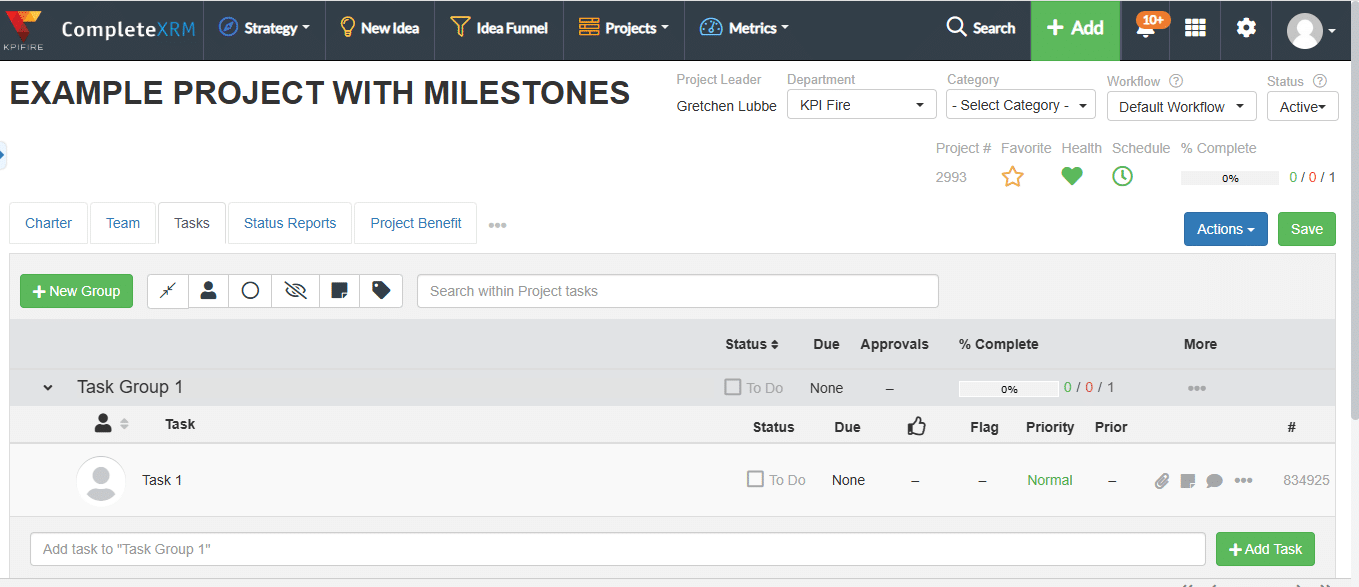Main Takeaways from This Article:
- Project milestones are critical checkpoints marking significant progress: They represent the completion of major phases, key deliverables, or important goals, serving as essential landmarks for tracking a project’s journey.
- Milestones are indispensable for effective project management: They provide tangible evidence of progress, enabling the verification of key objectives, effective resource allocation, and the assurance that project tasks remain aligned with overarching strategic goals.
- Effective project milestones share key characteristics: To be truly useful, milestones should be Specific and Measurable, Achievable and Realistic, Time-Bound, and directly Aligned with Project Goals.
- A structured approach to setting, using, and reporting milestones is crucial: This involves defining clear and achievable milestones with deadlines, aligning them with project goals, tracking progress regularly, reporting completions and adjusting milestones when necessary.
- Tools like KPI Fire can significantly enhance milestone management: These platforms offer real-time tracking, visual progress charts, automated reporting, data-driven insights, and support for continuous improvement programs.
What Are Milestones in Project Management?
Project milestones are critical checkpoints within a project’s schedule, marking the completion of significant phases or the delivery of key outputs. These important points are essential for monitoring the project’s advancement and keeping it aligned with the planned timeline. Milestones should represent substantial achievements, such as the finalization of a major deliverable, a critical approval, or the end of a project stage, rather than small, everyday tasks. By focusing on these major accomplishments, stakeholders gain a clear understanding of the project’s overall progress.
Importance of Project Milestones
Project milestones are indispensable for effective strategic project management; they are the critical signposts that confirm the achievement of key objectives at defined points in the project lifecycle. By providing tangible evidence of progress, milestones enable businesses to verify that crucial team goals are being met as the project unfolds.
Track Progress on Critical Tasks
Milestones act as measurable checkpoints, enabling businesses to track how much of the project has been completed at specific times. These markers provide essential visibility into the project’s advancement, clearly showing how near or far the team is from reaching its final objectives.
Manage Resources Effectively
By marking significant stages, milestones allow businesses to strategically allocate resources like budget, personnel, and equipment when they are most needed. This focused allocation, guided by milestone achievements, promotes efficient resource use and enables timely adjustments if necessary.
Ensure Alignment of Project Tasks with Strategic Goals
Milestones serve as key indicators that help ensure the project remains focused on the organization’s overarching strategic aims. Each significant achievement represented by a milestone confirms that the project’s progress aligns with and contributes to the company’s long-term vision.
Provide Clear Milestones to Stay on Schedule
Without clear milestones, it becomes difficult to objectively assess if the project is progressing according to the planned timeline. This lack of visibility can lead to unnoticed delays, increased uncertainty among stakeholders, and a misalignment of expectations regarding project completion.
Project Milestones Examples
Project milestones are not uniform; they are specifically defined based on the unique workflows and critical success factors of various industries and the distinct objectives of different project types. What constitutes a key achievement in a construction project, for instance, will differ significantly from a milestone in a software development endeavor.
Here are some real-world examples of project milestones across different industries:
Manufacturing
- Milestone 1: Finalization of Product Design. This milestone signifies the completion and approval of all product specifications and blueprints. Its role is to provide a clear and stable foundation for the manufacturing process, impacting the business by preventing costly design changes later and ensuring efficient production setup.
- Milestone 2: Successful Pilot Production Run. Achieving this milestone means a small-scale production run has been completed and the products meet quality standards. It’s crucial for validating the manufacturing process and identifying potential issues before mass production, impacting the business by reducing the risk of large-scale defects and ensuring production feasibility.
- Milestone 3: Completion of First Customer Order. This milestone represents the successful fulfillment of the initial customer order. It marks the transition from production to sales and revenue generation, impacting the business by demonstrating market demand and the effectiveness of the supply chain.
- Milestone 4: Achievement of Target Production Volume. This milestone indicates that the manufacturing process has reached a specified level of output efficiency. It’s important for meeting market demand and achieving economies of scale, impacting the business by maximizing profitability and market share.
Marketing Campaign
- Milestone 1: Campaign Launch. This milestone marks the official start of the marketing campaign across all planned channels. Its role is to begin engaging the target audience and generating initial awareness, impacting the business by initiating lead generation and brand building.
- Milestone 2: Completion of Key Content Creation. This milestone signifies the finalization of all core marketing materials, such as ad creatives, website copy, and social media posts. It ensures that all necessary assets are ready for deployment, impacting the business by enabling a consistent and comprehensive campaign message.
- Milestone 3: Reaching a Specific Engagement Metric (e.g., X% click-through rate, Y number of leads). This milestone indicates that the campaign is achieving predefined performance targets. Its role is to assess the effectiveness of the marketing activities and inform necessary optimizations, impacting the business by demonstrating progress towards campaign goals and ROI.
- Milestone 4: Campaign Conclusion and Reporting. This milestone marks the end of the active campaign period and the completion of a comprehensive performance analysis. It’s crucial for understanding the campaign’s overall impact and identifying learnings for future initiatives, impacting the business by providing valuable insights for marketing strategy improvement.
SaaS Development
- Milestone 1: Release of Minimum Viable Product (MVP). This milestone signifies the launch of the initial version of the software with core functionalities. Its role is to get the product into the hands of early users for feedback and validation, impacting the business by enabling early market testing and iterative development.
- Milestone 2: Integration of Key Feature Set. This milestone marks the successful development and implementation of a significant group of new features. It expands the product’s value proposition and caters to a broader user base, impacting the business by attracting more customers and potentially increasing subscription revenue.
- Milestone 3: Successful Completion of Beta Testing. Achieving this milestone indicates that the software has been rigorously tested by a select group of users and critical bugs have been addressed. It’s crucial for ensuring product stability and user satisfaction before a wider release, impacting the business by reducing the risk of negative feedback and improving user adoption.
- Milestone 4: Achievement of a Target Number of Paying Subscribers. This milestone represents a significant commercial success point. It validates the product’s market appeal and the effectiveness of the sales and marketing efforts, directly impacting the business by generating sustainable revenue and demonstrating product-market fit.
Construction
- Milestone 1: Groundbreaking and Site Mobilization. This milestone marks the official commencement of construction activities on the site. Its role is to physically initiate the project and set up the necessary infrastructure, impacting the business by signifying the start of the tangible construction phase.
- Milestone 2: Completion of Structural Framework. This milestone signifies the erection of the building’s main structural components. It’s a major step demonstrating significant physical progress and allowing subsequent phases like exterior and interior work to begin, impacting the business by indicating that the project is taking shape.
- Milestone 3: Building Enclosure Completed (Roofing, Walls, Windows). Achieving this milestone means the building is sealed off from the elements. It allows for interior work to proceed regardless of weather conditions, impacting the business by protecting the investment and enabling parallel construction activities.
- Milestone 4: Final Inspection and Occupancy Permit. This milestone marks the official completion of the construction project and the granting of authorization for use. It’s the ultimate goal of the construction phase, directly impacting the business by allowing for handover to the client or commencement of operations.
Key Characteristics of Effective Project Milestones
To be truly useful, project milestones need specific characteristics. These features make them actionable, easy to measure, and directly linked to achieving the project’s goals.
Specific and Measurable
Effective milestones must be specific and measurable, clearly defining what needs to be accomplished. This clarity sets precise expectations for the team and provides a tangible way to monitor progress against those expectations.
Achievable and Realistic
Milestones should also be achievable and realistic, taking into account available resources and the project timeline. Setting attainable goals helps maintain team motivation and focus, minimizing the likelihood of setbacks and discouragement.
Time-Bound
Each milestone needs to be time-bound, meaning it should have a clearly defined deadline. This temporal aspect fosters accountability within the team and drives focused effort toward meeting those specific target dates.
Aligned with Project Goals
Crucially, every milestone should directly support the broader project goals and align with the overarching strategic vision. This ensures that the achievement of each milestone meaningfully contributes to the overall success of the project.
Milestone Planning Phase
Planning milestones at the outset of a project is crucial for maintaining its trajectory. This early definition provides a clear roadmap, establishes the project’s key deliverables, and fosters strategic alignment among team members right from the beginning. By identifying major phases and deliverables early on, the team can strategically allocate resources and schedule tasks more efficiently. This proactive approach helps to prevent potential delays and minimizes confusion as the project progresses.
How to Set, Use, and Report Project Milestones
Setting, using, and reporting project milestones are vital for guiding a project to successful completion. These steps provide a roadmap, track progress, and keep everyone informed.
1. Define Clear and Achievable Milestones
Clearly defined milestones act as signposts, marking key deliverables or significant phases of the project. Each milestone should be something the team can realistically achieve with the resources and time available. Breaking down big goals into smaller, manageable milestones makes them easier to track and accomplish.
2. Set Milestone Schedules with Clear Deadlines
Assigning a specific deadline to each milestone is crucial for keeping the project on schedule and ensuring team accountability. While these deadlines should be realistic and might need adjustments, they create a sense of urgency. Spreading milestones evenly throughout the project timeline helps prevent logjams and allows sufficient time for each to be completed.
3. Align Milestones with Project Goals
Every milestone should directly support the larger objectives of the project. This alignment ensures that the daily tasks contribute to the overall strategy and move the project toward its business goals. Clearly linking each milestone to specific outcomes helps demonstrate its value in achieving these goals.
4. Track Milestone Progress Regularly
Monitoring progress against milestones is essential to keep the project on track. Regular tracking allows project managers to spot potential problems early and make necessary adjustments to the plan. Scheduling regular check-ins or meetings helps to review progress on each milestone and address any roadblocks quickly.
5. Report Milestone Completion to Stakeholders
Regularly reporting when milestones are completed keeps stakeholders informed about the project’s advancement. Using tools like KPI Fire can automate this reporting, providing real-time updates and clear visual indicators of progress for stakeholders. These reports promote transparency and ensure everyone stays aligned.
6. Adjust Milestones When Necessary
Flexibility is key in project management. If the project falls behind, milestones might need to be adjusted to ensure it still aligns with the overall goals. Project managers should regularly review milestones and be prepared to modify timelines or objectives if unexpected issues arise, such as delays or changes in scope.

Best Practices for Tracking and Managing Project Milestones
To effectively track and manage project milestones, businesses must adopt proven best practices. These practices ensure projects stay on course and deliver the intended results.
Regularly Review Milestone Progress
Reviewing milestone progress regularly is key to staying on track and aligned with the project’s main goals. Businesses should aim for weekly or bi-weekly reviews to check progress and make any necessary changes. These reviews help ensure the project continues to support the overall strategic vision.
Prioritize Project Execution Milestones Based on Impact
Not all milestones have the same importance; some significantly impact the overall project. By focusing on the most critical milestones, businesses can maximize value and create a culture of strategy execution. It’s helpful to assess milestones based on business needs and their effect on the project. Key milestones should be watched closely, while others can have more flexible timelines.
Document and Track Dependencies
Understanding how milestones are linked is important because completing one often depends on finishing another. Businesses should document these dependencies to avoid delays and ensure a smooth workflow.
Adjust Milestones for Changing Project Conditions
Sometimes, project situations change, and milestones need to be updated to remain realistic and achievable. Businesses should regularly check progress and adjust milestones if unexpected delays or changes happen. This flexibility helps the project overcome challenges and stay aligned with its strategic aims.
Use Project Management Software
Using project management software like KPI Fire helps visualize milestones and track progress in real time. KPI Fire’s dashboards offer a simple way to monitor project milestones and keep all team members and stakeholders informed about the progress.
Common Mistakes to Avoid
Businesses often stumble when setting milestones by making them too vague or unrealistic, hindering progress tracking and team motivation. To overcome this, however, it’s crucial to define SMART (Specific, Measurable, Achievable, Relevant, Time-bound) milestones that provide clarity and a clear path forward.
Setting Unrealistic Milestones
To begin with, establishing milestones that are out of reach can significantly demotivate teams, fostering a sense of futility and inevitably causing project timelines to slip. Consequently, it’s crucial to ensure that these checkpoints are genuinely achievable, taking into account the available time and resources. Therefore, a practical approach involves leveraging historical data from similar projects or established industry benchmarks to inform the goal-setting process, thereby striking a balance between ambitious targets and attainable realities.
Misalignment with Business Goals
Furthermore, it’s essential to recognize that project milestones should directly support the overarching strategic objectives of the company. Otherwise, misaligned milestones can lead to a dissipation of energy and resources on activities that don’t contribute to the bigger picture. For this reason, a proactive stance includes the regular review of milestones to confirm their continued relevance in the face of evolving business priorities or changing external circumstances.
Lack of Communication
Finally, the impact of poor communication in project management, particularly concerning milestones, cannot be overstated. Indeed, without consistent updates and a clear understanding among all stakeholders, projects risk losing direction and potentially stalling altogether. To mitigate this, establishing routine milestone review meetings and employing tools such as KPI Fire can prove invaluable, as they facilitate real-time information sharing and ensure everyone remains on the same page.
How KPI Fire Aligns Milestones with Strategic Goals
Here’s an explanation of how KPI Fire supports milestone management, focusing on its practical applications:
KPI Fire is more than just a tool; it’s a practical application that directly supports milestone management, ensuring projects stay on track and aligned with strategic objectives. It offers a suite of features designed to streamline the process and enhance visibility.
-
Real-Time Tracking and Monitoring: KPI Fire provides real-time tracking of milestones and their alignment with strategic goals. Consequently, businesses can monitor progress at every stage and ensure milestones are met on time.
-
Visualize Progress with a Milestone Chart: Furthermore, KPI Fire’s customizable dashboards enable businesses to visualize milestones and KPIs through a milestone chart. This feature, therefore, helps businesses track their project progress and performance in real time, ensuring they remain aligned with their strategic goals.
-
Automated Milestone Reporting and Updates: Additionally, KPI Fire automates milestone reporting, reducing the time spent on manual updates and providing stakeholders with real-time progress reports.
-
Data-Driven Decision-Making: Moreover, KPI Fire offers actionable insights and recommendations based on milestone performance and strategic alignment. These insights, in turn, help businesses make data-driven decisions to keep projects on track.
-
Continuous Improvement and Adaptability: Finally, KPI Fire assists businesses in continuously improving with best practices such as adjusting and adapting their milestones based on real-time performance data. This ensures that the project remains aligned with evolving strategic goals.
Drive Strategic Success with Aligned Milestones and KPI Fire
Project milestones serve as crucial checkpoints that not only help track progress and manage resources effectively but also ensure every step aligns with overarching strategic goals, thereby keeping projects focused and ultimately successful.
KPI Fire significantly simplifies the entire process of setting, meticulously tracking, and clearly reporting these vital milestones, ensuring that businesses consistently stay aligned with both their immediate project objectives and their broader business strategy. Consequently, to witness firsthand how KPI Fire can revolutionize your milestone management and guarantee projects are completed both on time and within budget, we encourage you to request a free demo now.




